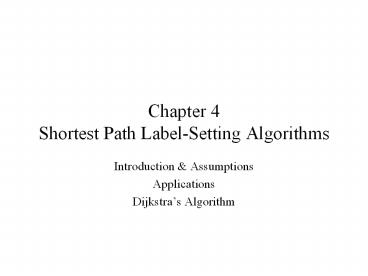Chapter 4 Shortest Path LabelSetting Algorithms - PowerPoint PPT Presentation
1 / 8
Title:
Chapter 4 Shortest Path LabelSetting Algorithms
Description:
For every node i s, find a shortest length directed path from s to i. Assumptions: All arc lengths are integers (if rational but not integer, multiply them by a ... – PowerPoint PPT presentation
Number of Views:74
Avg rating:3.0/5.0
Title: Chapter 4 Shortest Path LabelSetting Algorithms
1
Chapter 4Shortest Path Label-Setting Algorithms
- Introduction Assumptions
- Applications
- Dijkstras Algorithm
2
Problem Definition Assumptions
- Problem Given a network G (N, A) in which
each arc (i, j) has an associated length or cost
cij, let node s be the source. The length of a
directed path is the sum of the lengths of the
arcs in the path. For every node i ? s, find a
shortest length directed path from s to i. - Assumptions
- All arc lengths are integers (if rational but not
integer, multiply them by a suitably large
number) - The network contains a directed path from node s
to every node i ? s (if not, add an arc (s, i)
with very large cost) - The network does not contain a negative cycle
(otherwise see Ch. 5) - The network is directed (transform undirected
arcs w/positive costs as in Ch. 2 undirected
arcs w/negative costs will create neg. cycles)
3
Types of Shortest Path Problems
- Single-source shortest path
- One node to all others with nonnegative arc
lengths Chapter 4 - Variations maximum capacity path, maximum
reliabiltiy path - One node to all others with arbitrary arc lengths
Chapter 5 - All-pairs shortest path every node to every
other node Chapter 5 - String model for shortest path from s to t
- Arcs strings, knots nodes hold s and t and
pull tight. - Shortest paths will be taut for i and j on a
shortest path connected by arc (i, j), distance
s-i plus cij ? distance s-j - Associated dual maximization problem pulling
s and t as far apart as possible
4
Single-Source Shortest Paths
- Solution is a shortest-path tree rooted at s.
- Property 4.1. If the path s i1 i2 ih
k is a shortest path from s to k, then for every
q 2, 3, , h-1, the subpath s i1 i2
iq is a shortest path from the source node to iq. - Property 4.2. Let the vector d represent the
shortest path distances. Then a directed path P
from s to k is a shortest path if and only if for - Store the shortest path tree as a vector of n-1
predecessor nodes pred(j) is the node i that
satisfies above equality.
5
Acyclic Networks Reaching
- Examine the nodes in topological order perform a
breadth-first search to find a shortest-path
tree. - Reaching Algorithm
- 0. d(s) ? 0, d(j) ?? for j ? s, i ? s
- 1. If A(i) is empty, then stop. Otherwise, to
examine node i, scan the arcs in A(i). If for
any arc (i, j), d(j) ? d(i) cij , then set d(j)
d(i) cij . - 2. Set i to the next node in topological order
and return to 1. - Solves shortest path problem on acyclic networks
in O(m) time.
6
Dijkstras Algorithm
- Shortest paths from source node to all other
nodes with nonnegative arc lengths (cycles
permitted) - Output
- d(i) is the distance from s to i along a
shortest path - pred(i) is the predecessor of i along a shortest
path - Intermediate
- S set of permanently labeled nodes (L in
GIDEN) - set of temporarily labeled nodes (P in GIDEN)
- GIDEN also has set U for unlabeled nodes
- At each iteration, one node moves to S from
7
Dijkstras Algorithm in GIDEN
8
Complexity
- Node selection requires time proportional to
- Distance updates are performed for each arc
emanating from node i total of m updates in the
entire algorithm - Since
- For dense networks,
- Complexity can be improved for sparse networks by
cleverness and special data structures































